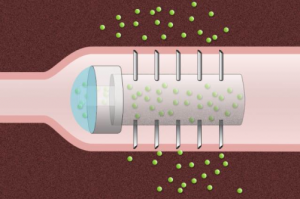While swallowing pills coated with tiny needles might at first blush evoke a plot device from a grade B horror movie, drug-delivery capsules with micro needle coating that can deliver drugs directly into the lining of the digestive tract may soon replace injections as the standard mode of administering many medications.
Most of us, given our ‘druthers, would prefer to take medication orally than by injection, but unfortunately, many drugs, especially ones made from large proteins, cannot be given in tablet or capsule form because their active therapeutic agents get broken down by acid and enzyme action in the stomach before they can be absorbed. The stomach’s protease and bacteria-rich environment with general pH variability ranging from pH 1 to 7, is an extreme environment that makes oral delivery particularly challenging for the biologic class of therapeutics.
However, a team of researchers at the Massachusetts Institute of Technology (MIT) of Cambridge, Massachusetts and Massachusetts General Hospital (MGH) Harvard Medical School have devised a novel drug capsule coated with tiny needles that can inject drugs directly into the lining of the stomach after the capsule is swallowed. In animal studies, the team found that the capsule delivered insulin more efficiently than injection under the skin, and there were no harmful side effects as the capsule passed through the digestive system.
 “This could be a way that the patient can circumvent the need to have an infusion or subcutaneous administration of a drug,” says Giovanni Traverso, a research fellow at MIT’s Koch Institute for Integrative Cancer Research, a gastroenterologist at MGH, and one of the lead authors of a paper reporting the MIT/MGH research team’s findings in the Journal of Pharmaceutical Sciences.
“This could be a way that the patient can circumvent the need to have an infusion or subcutaneous administration of a drug,” says Giovanni Traverso, a research fellow at MIT’s Koch Institute for Integrative Cancer Research, a gastroenterologist at MGH, and one of the lead authors of a paper reporting the MIT/MGH research team’s findings in the Journal of Pharmaceutical Sciences.
The paper, entitled “Microneedles for Drug Delivery via the Gastrointestinal Tract“, (Journal of Pharmaceutical Sciences, 2014; DOI: 10.1002/jps.24182), is coauthored by Giovanni Traverso; Carl M. Schoellhammer; Avi Schroeder, a former Koch Institute postdoc; Daniel Blankschtein — the Herman P. Meissner Professor of Chemical Engineering; Daniel Anderson, the Samuel A. Goldblith Associate Professor of Chemical Engineering and a member of the Koch Institute and IMES; and Robert Langer, the David H. Koch Institute Professor at MIT and a member of the Koch Institute, the Institute for Medical Engineering and Science (IMES) as well as Ruby Maa, Gregory Y. Lauwers, and Baris E. Polat, representing the Massachusetts Institute of Technology’s Koch Institute for Integrative Cancer Research and various departments at Massachusetts General Hospital, Harvard Medical School, the Department of Chemical Engineering, Technion – Israel Institute of Technology, Haifa, Israel, the Institute for Medical Engineering and Science, Massachusetts Institute of Technology, Cambridge, and the Harvard-MIT Division of Health Science and Technology, Cambridge.
The researchers describe how they demonstrated in three proof-of-concept experiments in swine that microneedle-based delivery has the capacity for improved bioavailability of a biologically active macromolecule. Moreover, they show that microneedle-containing devices can be passed and excreted from the GI tract safely — findings that strongly support the success of implementation of micro needle technology for use in the GI tract in diseases such as Inflammatory Bowel Disease.
Although the researchers tested their capsule with insulin, they anticipate that it would be most useful for delivering biopharmaceuticals such as antibodies, which are used to treat cancer and autoimmune disorders like arthritis and Crohn’s disease. This class of drugs, known as “biologics,” also includes vaccines, recombinant DNA, and RNA.
 “The large size of these biologic drugs makes them nonabsorbable. And before they even would be absorbed, they’re degraded in your GI tract by acids and enzymes that just eat up the molecules and make them inactive,” says Carl Schoellhammer, a a fifth-year Ph.D. student student in chemical engineering working on strategies for non-invasive oral and transdermal drug delivery and vaccination, and a lead author of the paper.
“The large size of these biologic drugs makes them nonabsorbable. And before they even would be absorbed, they’re degraded in your GI tract by acids and enzymes that just eat up the molecules and make them inactive,” says Carl Schoellhammer, a a fifth-year Ph.D. student student in chemical engineering working on strategies for non-invasive oral and transdermal drug delivery and vaccination, and a lead author of the paper.

The MIT release notes that scientists have previously tried designing microparticles and nanoparticles that can deliver biologics, but these technologies are expensive to produce and require a new version to be engineered for each drug.
Mr. Schoellhammer, Dr. Traverso, and their colleagues set out to design a capsule that would serve as a platform for the delivery of a wide range of therapeutics, prevent degradation of the drugs, and inject the payload directly into the lining of the GI tract. Their prototype acrylic capsule, two centimeters long and one centimeter in diameter, includes a reservoir for the drug and is coated with hollow, stainless steel needles about five millimeters long.
Previous studies of accidental ingestion of sharp objects in human patients had suggested that it could be safe to swallow a capsule coated with short needles. Because there are no pain receptors in the GI tract, patients would not feel any pain from the drug injection.
The proof-of-concept experiments in pigs were to test whether this type of capsule could allow safe and effective drug delivery, with insulin as the drug payload. It took more than a week for the capsules to move through the entire digestive tract, and the researchers report that they found no traces of tissue damage, supporting the potential safety of this novel approach.
The scientists also found that the microneedles successfully injected insulin into the lining of the stomach, small intestine, and colon, causing the animals’ blood glucose levels to drop. This reduction in blood glucose was faster and larger than the drop seen when the same amount of insulin was given by subcutaneous injection.
“The kinetics are much better, and much faster-onset, than those seen with traditional under-the-skin administration, Dr. Traverso says. “For molecules that are particularly difficult to absorb, this would be a way of actually administering them at much higher efficiency.”
 “This is a very interesting approach,” says Samir Mitragotri, a professor of chemical engineering at the University of California at Santa Barbara who was not involved in the MIT/MGH research. “Oral delivery of drugs is a major challenge, especially for protein drugs. There is tremendous motivation on various fronts for finding other ways to deliver drugs without using the standard needle and syringe.”
“This is a very interesting approach,” says Samir Mitragotri, a professor of chemical engineering at the University of California at Santa Barbara who was not involved in the MIT/MGH research. “Oral delivery of drugs is a major challenge, especially for protein drugs. There is tremendous motivation on various fronts for finding other ways to deliver drugs without using the standard needle and syringe.”
This approach could also be used to administer vaccines that normally have to be injected, the researchers say.
In ongoing research, the team next plans to modify the capsule so that peristalsis — contractions of the digestive tract — would slowly squeeze the drug out of the capsule as it travels through the tract. They are also working on capsules with needles made of degradable polymers and sugar that would break off and become embedded in the gut lining, where they would slowly disintegrate and release the drug, and further minimize any safety concern.
Sources:
Massachusetts Institute of Technology
Journal of Pharmaceutical Sciences
Image Credits:
Massachusetts Institute of Technology
Christine Daniloff/MIT
University of California at Santa Barbara

